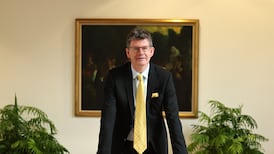ONE BULLET was all it took to change the course of German history. The shot, on June 2nd, 1967, killed a West Berlin student, enraged a generation and sparked the student revolution that found its extreme end in the 1970s campaign of extreme-left terrorism.
The man who fired the shot, policeman Karl-Heinz Kurras, claimed during his trial that he fired his gun during a struggle – and he was acquitted. Four decades later, Kurras was exposed as an informer for the East German secret police, the Stasi, his file filling 17 folders.
That revelation prompted speculation that his actions were that of an agent provocateur.
Now Der Spiegelhas published documents that suggest the killing was not a Stasi conspiracy, but a West Berlin police cover-up.
The cover-up began around West Berlin’s Deutsche Oper on June 2nd with the visit of the Iranian Shah, Resa Pahlewi. At a protest against his repressive regime, students waved banners and threw stones, paintballs and tomatoes. West Berlin police intervened, beating student protesters and chasing others as they escaped.
Police officer Kurras ran onto the courtyard of a side-street apartment where, during questioning later, he claimed he was surrounded by an “out-of- control mob”. He pulled his Walther PPK pistol and, following two warning shots, fired a third time.
The following day on the news, he claimed he learned that this final shot had wounded Benno Ohnesorg, fatally.
Despite “doubts” about Kurras’s version of events, his trial judge released him saying there was no evidence the police officer deliberately targeted the student.
However, newly uncovered photos threw fresh doubt on Kurras’s version. He was not surrounded by a mob of students, rather Ohnesorg was, in his last moments, surrounded by police officers. A series of photos suggest Kurras – later cropped out – approached the student from behind. Seconds later Ohnesorg is lying on the ground, bleeding profusely. Digital magnification and retouching has revealed Kurras’s shocked face, staring at the ground with wide eyes.
Claims of a Stasi conspiracy are, Der Spiegelsuggests, far-fetched. A police cover-up to protect one of their own seems more likely.
In an audio recording from the scene a man, believed to be Kurras’s superior, is heard shouting: “Kurras, get back! Away! Quick, go!” Photos exist of the two men standing near each other in the courtyard. At the trial, however, the same officer said he never saw Kurras at the scene.
Later, in hospital, doctors sewed up the gunshot wound after their autopsy, while the piece of Ohnesorg’s skull shattered by the bullet vanished the next day. The cause of death was recorded: “Head injuries through blunt instrument.”
“It’s far worse than our worst fantasies at the time,” said Hans- Christian Ströbele, a former student leader, now Green Party Bundestag MP. “If someone told us all this, then we’d have written it off as a conspiracy theory.”
Questioned by Der Spiegellast week about the shooting, Mr Kurras (86) said: "I'm not well, enough has been written about that."









